Aidan J. Hughes
Cost-informed dimensionality reduction for structural digital twin technologies
Sep 17, 2024Abstract:Classification models are a key component of structural digital twin technologies used for supporting asset management decision-making. An important consideration when developing classification models is the dimensionality of the input, or feature space, used. If the dimensionality is too high, then the `curse of dimensionality' may rear its ugly head; manifesting as reduced predictive performance. To mitigate such effects, practitioners can employ dimensionality reduction techniques. The current paper formulates a decision-theoretic approach to dimensionality reduction for structural asset management. In this approach, the aim is to keep incurred misclassification costs to a minimum, as the dimensionality is reduced and discriminatory information may be lost. This formulation is constructed as an eigenvalue problem, with separabilities between classes weighted according to the cost of misclassifying them when considered in the context of a decision process. The approach is demonstrated using a synthetic case study.
Active learning for regression in engineering populations: A risk-informed approach
Sep 06, 2024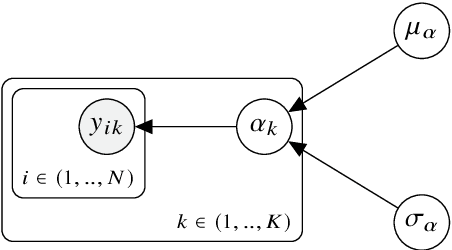



Abstract:Regression is a fundamental prediction task common in data-centric engineering applications that involves learning mappings between continuous variables. In many engineering applications (e.g.\ structural health monitoring), feature-label pairs used to learn such mappings are of limited availability which hinders the effectiveness of traditional supervised machine learning approaches. The current paper proposes a methodology for overcoming the issue of data scarcity by combining active learning with hierarchical Bayesian modelling. Active learning is an approach for preferentially acquiring feature-label pairs in a resource-efficient manner. In particular, the current work adopts a risk-informed approach that leverages contextual information associated with regression-based engineering decision-making tasks (e.g.\ inspection and maintenance). Hierarchical Bayesian modelling allow multiple related regression tasks to be learned over a population, capturing local and global effects. The information sharing facilitated by this modelling approach means that information acquired for one engineering system can improve predictive performance across the population. The proposed methodology is demonstrated using an experimental case study. Specifically, multiple regressions are performed over a population of machining tools, where the quantity of interest is the surface roughness of the workpieces. An inspection and maintenance decision process is defined using these regression tasks which is in turn used to construct the active-learning algorithm. The novel methodology proposed is benchmarked against an uninformed approach to label acquisition and independent modelling of the regression tasks. It is shown that the proposed approach has superior performance in terms of expected cost -- maintaining predictive performance while reducing the number of inspections required.
Multitask learning for improved scour detection: A dynamic wave tank study
Aug 29, 2024Abstract:Population-based structural health monitoring (PBSHM), aims to share information between members of a population. An offshore wind (OW) farm could be considered as a population of nominally-identical wind-turbine structures. However, benign variations exist among members, such as geometry, sea-bed conditions and temperature differences. These factors could influence structural properties and therefore the dynamic response, making it more difficult to detect structural problems via traditional SHM techniques. This paper explores the use of a Bayesian hierarchical model as a means of multitask learning, to infer foundation stiffness distribution parameters at both population and local levels. To do this, observations of natural frequency from populations of structures were first generated from both numerical and experimental models. These observations were then used in a partially-pooled Bayesian hierarchical model in tandem with surrogate FE models of the structures to infer foundation stiffness parameters. Finally, it is demonstrated how the learned parameters may be used as a basis to perform more robust anomaly detection (as compared to a no-pooling approach) e.g. as a result of scour.
Quantifying the value of positive transfer: An experimental case study
Jul 19, 2024Abstract:In traditional approaches to structural health monitoring, challenges often arise associated with the availability of labelled data. Population-based structural health monitoring seeks to overcomes these challenges by leveraging data/information from similar structures via technologies such as transfer learning. The current paper demonstrate a methodology for quantifying the value of information transfer in the context of operation and maintenance decision-making. This demonstration, based on a population of laboratory-scale aircraft models, highlights the steps required to evaluate the expected value of information transfer including similarity assessment and prediction of transfer efficacy. Once evaluated for a given population, the value of information transfer can be used to optimise transfer-learning strategies for newly-acquired target domains.
Quantifying the value of information transfer in population-based SHM
Nov 06, 2023Abstract:Population-based structural health monitoring (PBSHM), seeks to address some of the limitations associated with data scarcity that arise in traditional SHM. A tenet of the population-based approach to SHM is that information can be shared between sufficiently-similar structures in order to improve predictive models. Transfer learning techniques, such as domain adaptation, have been shown to be a highly-useful technology for sharing information between structures when developing statistical classifiers for PBSHM. Nonetheless, transfer-learning techniques are not without their pitfalls. In some circumstances, for example if the data distributions associated with the structures within a population are dissimilar, applying transfer-learning methods can be detrimental to classification performance -- this phenomenon is known as negative transfer. Given the potentially-severe consequences of negative transfer, it is prudent for engineers to ask the question `when, what, and how should one transfer between structures?'. The current paper aims to demonstrate a transfer-strategy decision process for a classification task for a population of simulated structures in the context of a representative SHM maintenance problem, supported by domain adaptation. The transfer decision framework is based upon the concept of expected value of information transfer. In order to compute the expected value of information transfer, predictions must be made regarding the classification (and decision performance) in the target domain following information transfer. In order to forecast the outcome of transfers, a probabilistic regression is used here to predict classification performance from a proxy for structural similarity based on the modal assurance criterion.
Sharing Information Between Machine Tools to Improve Surface Finish Forecasting
Oct 09, 2023Abstract:At present, most surface-quality prediction methods can only perform single-task prediction which results in under-utilised datasets, repetitive work and increased experimental costs. To counter this, the authors propose a Bayesian hierarchical model to predict surface-roughness measurements for a turning machining process. The hierarchical model is compared to multiple independent Bayesian linear regression models to showcase the benefits of partial pooling in a machining setting with respect to prediction accuracy and uncertainty quantification.
A decision framework for selecting information-transfer strategies in population-based SHM
Jul 13, 2023Abstract:Decision-support for the operation and maintenance of structures provides significant motivation for the development and implementation of structural health monitoring (SHM) systems. Unfortunately, the limited availability of labelled training data hinders the development of the statistical models on which these decision-support systems rely. Population-based SHM seeks to mitigate the impact of data scarcity by using transfer learning techniques to share information between individual structures within a population. The current paper proposes a decision framework for selecting transfer strategies based upon a novel concept -- the expected value of information transfer -- such that negative transfer is avoided. By avoiding negative transfer, and by optimising information transfer strategies using the transfer-decision framework, one can reduce the costs associated with operating and maintaining structures, and improve safety.
Towards risk-informed PBSHM: Populations as hierarchical systems
Mar 13, 2023Abstract:The prospect of informed and optimal decision-making regarding the operation and maintenance (O&M) of structures provides impetus to the development of structural health monitoring (SHM) systems. A probabilistic risk-based framework for decision-making has already been proposed. However, in order to learn the statistical models necessary for decision-making, measured data from the structure of interest are required. Unfortunately, these data are seldom available across the range of environmental and operational conditions necessary to ensure good generalisation of the model. Recently, technologies have been developed that overcome this challenge, by extending SHM to populations of structures, such that valuable knowledge may be transferred between instances of structures that are sufficiently similar. This new approach is termed population-based structural heath monitoring (PBSHM). The current paper presents a formal representation of populations of structures, such that risk-based decision processes may be specified within them. The population-based representation is an extension to the hierarchical representation of a structure used within the probabilistic risk-based decision framework to define fault trees. The result is a series, consisting of systems of systems ranging from the individual component level up to an inventory of heterogeneous populations. The current paper considers an inventory of wind farms as a motivating example and highlights the inferences and decisions that can be made within the hierarchical representation.
Mitigating sampling bias in risk-based active learning via an EM algorithm
Jun 25, 2022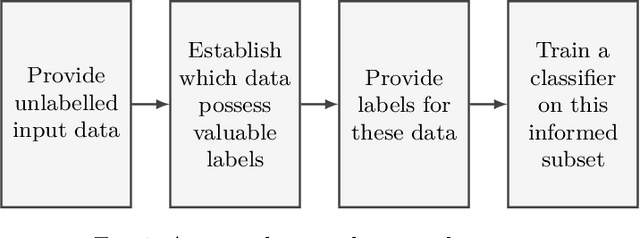

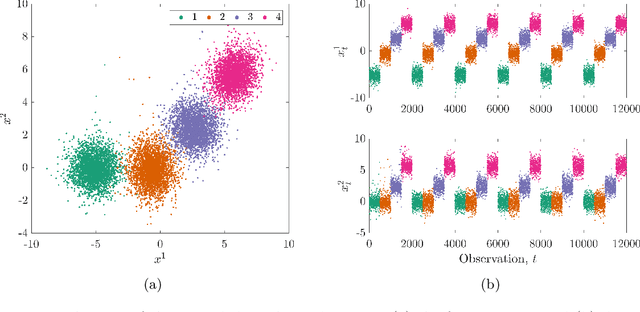
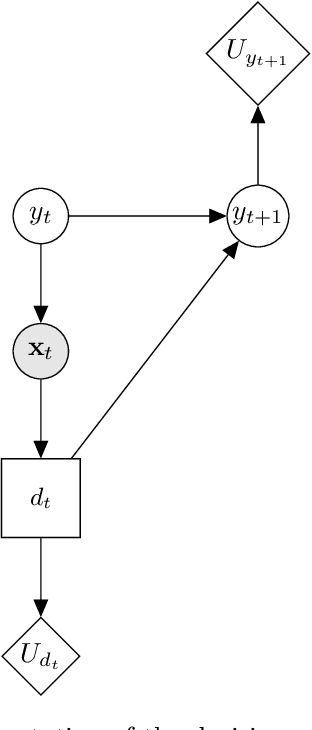
Abstract:Risk-based active learning is an approach to developing statistical classifiers for online decision-support. In this approach, data-label querying is guided according to the expected value of perfect information for incipient data points. For SHM applications, the value of information is evaluated with respect to a maintenance decision process, and the data-label querying corresponds to the inspection of a structure to determine its health state. Sampling bias is a known issue within active-learning paradigms; this occurs when an active learning process over- or undersamples specific regions of a feature-space, thereby resulting in a training set that is not representative of the underlying distribution. This bias ultimately degrades decision-making performance, and as a consequence, results in unnecessary costs incurred. The current paper outlines a risk-based approach to active learning that utilises a semi-supervised Gaussian mixture model. The semi-supervised approach counteracts sampling bias by incorporating pseudo-labels for unlabelled data via an EM algorithm. The approach is demonstrated on a numerical example representative of the decision processes found in SHM.
Improving decision-making via risk-based active learning: Probabilistic discriminative classifiers
Jun 23, 2022
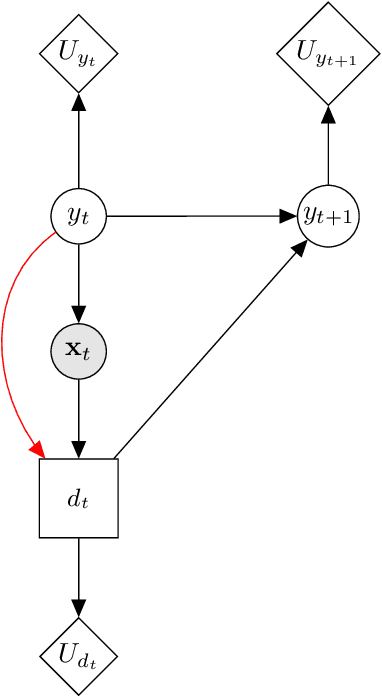
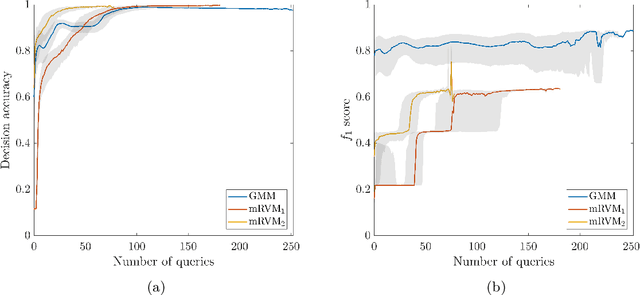

Abstract:Gaining the ability to make informed decisions on operation and maintenance of structures provides motivation for the implementation of structural health monitoring (SHM) systems. However, descriptive labels for measured data corresponding to health-states of the monitored system are often unavailable. This issue limits the applicability of fully-supervised machine learning paradigms for the development of statistical classifiers to be used in decision-support in SHM systems. One approach to dealing with this problem is risk-based active learning. In such an approach, data-label querying is guided according to the expected value of perfect information for incipient data points. For risk-based active learning in SHM, the value of information is evaluated with respect to a maintenance decision process, and the data-label querying corresponds to the inspection of a structure to determine its health state. In the context of SHM, risk-based active learning has only been considered for generative classifiers. The current paper demonstrates several advantages of using an alternative type of classifier -- discriminative models. Using the Z24 Bridge dataset as a case study, it is shown that discriminative classifiers have benefits, in the context of SHM decision-support, including improved robustness to sampling bias, and reduced expenditure on structural inspections.
 Add to Chrome
Add to Chrome Add to Firefox
Add to Firefox Add to Edge
Add to Edge